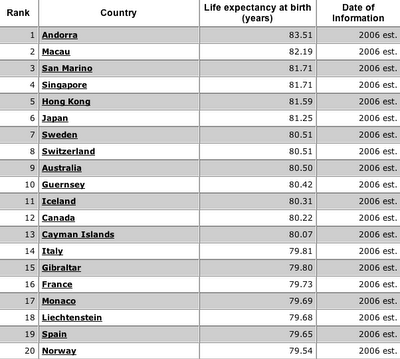Saturday, May 20, 2006
Thursday, May 18, 2006
I'm lost
When I'm stressed, smoke gets in my eyes ...



Photographs from secondary source
Go back to the main post of this week: Eclipses



... so please give me some clarity.
Photographs from secondary source
Go back to the main post of this week: Eclipses
Black and white
Photographs of my brother:
1. Playing karate

2. Doing homework


3. With Kim Clijsters
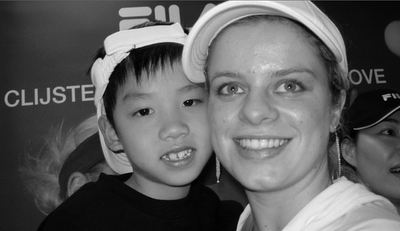
4. What is he up to now?

Photographs taken and edited by me
Go back to the main post of this week: Eclipses
1. Playing karate

2. Doing homework


3. With Kim Clijsters

4. What is he up to now?

Photographs taken and edited by me
Go back to the main post of this week: Eclipses
Wednesday, May 17, 2006
Eclipses
Not really an expert in the field, but I think these events are noteworthy as they remind us that we live in a vast world.
Let me introduce these three celestial bodies to you first:
1. Earth
The planet that orbits the sun between the planets Venus and Mars at a mean distance from the sun of 149600000 km. It has a mass of about 5975000000000000000000000 kg (I would use standard form if I could) and an equatorial diameter of 12756.3 km. The earth consists of three layers: the gaseous atmosphere, the liquid hydrosphere, and the solid lithosphere. The solid part of the earth also consists of three layers: the crust, with a mean thickness of about 32 km under the land nad 10 km under the seas; the mantle, which extends some 2900 km below the crust; and the core, part of which is believed to be liquid, have a maximum relative density of 13 and a maximum temperature of 6400 K. (0 Kelvin = - 273ºC; linear relationship)

2. Moon
Earth's only natural satellite, which orbits the earth at a mean distance of 384400 km. It has a diameter of 3476 km. It has no atmosphere or surface water. Its surface temperature varies between 80 K and 400 K. It is the only celestial body outside the earth to have been reached by man.
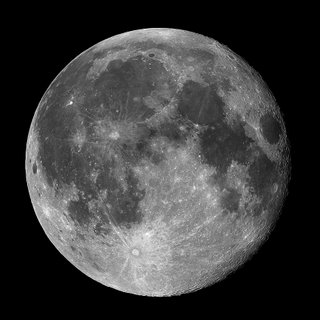
3. Sun
The star at the centre of the solar system. It is a typical main-sequence dwarf star (I can't believe I still remember some Astrophysics I learnt a while ago). It has a diameter of about 1329000 km and a mass of 1900000000000000000000000000000 kg. Hydrogen (75%) and helium (25%) are the main constituents, with less than 1% heavier elements. Its surface temperature can reach 5800 K, while its core can reach 15600000 K.

Now to the fun part:
1. Total solar eclipse
Occurs when when the sun, earth, and moon are aligned and the full shadow of the moon falls on earth.
Most recent total solar eclipse event: March 29, 2006

2. Total lunar eclipse
Occurs when the sun, earth, and moon are aligned and the shadow of the earth falls on the moon and covers it completely.
Most recent total lunar eclipse event: October 28, 2004
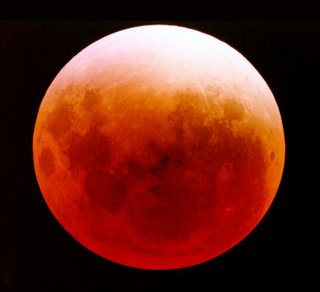
Hi-res photos from various sources.
More info at NASA Eclipses
Let me introduce these three celestial bodies to you first:
1. Earth
The planet that orbits the sun between the planets Venus and Mars at a mean distance from the sun of 149600000 km. It has a mass of about 5975000000000000000000000 kg (I would use standard form if I could) and an equatorial diameter of 12756.3 km. The earth consists of three layers: the gaseous atmosphere, the liquid hydrosphere, and the solid lithosphere. The solid part of the earth also consists of three layers: the crust, with a mean thickness of about 32 km under the land nad 10 km under the seas; the mantle, which extends some 2900 km below the crust; and the core, part of which is believed to be liquid, have a maximum relative density of 13 and a maximum temperature of 6400 K. (0 Kelvin = - 273ºC; linear relationship)

2. Moon
Earth's only natural satellite, which orbits the earth at a mean distance of 384400 km. It has a diameter of 3476 km. It has no atmosphere or surface water. Its surface temperature varies between 80 K and 400 K. It is the only celestial body outside the earth to have been reached by man.

3. Sun
The star at the centre of the solar system. It is a typical main-sequence dwarf star (I can't believe I still remember some Astrophysics I learnt a while ago). It has a diameter of about 1329000 km and a mass of 1900000000000000000000000000000 kg. Hydrogen (75%) and helium (25%) are the main constituents, with less than 1% heavier elements. Its surface temperature can reach 5800 K, while its core can reach 15600000 K.

Now to the fun part:
1. Total solar eclipse
Occurs when when the sun, earth, and moon are aligned and the full shadow of the moon falls on earth.
Most recent total solar eclipse event: March 29, 2006

2. Total lunar eclipse
Occurs when the sun, earth, and moon are aligned and the shadow of the earth falls on the moon and covers it completely.
Most recent total lunar eclipse event: October 28, 2004

Hi-res photos from various sources.
More info at NASA Eclipses
Monday, May 15, 2006
News of the day 1
From South China Morning Post, Education Section
By Richard Garner
Indian and Chinese pupils focus on science
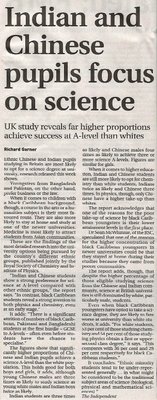
Ethnic Chinese and Indian pupils studying in Britain are most likely to opt for a science degree at university, research released this week shows.
Youngsters from Bangladesh and Pakistan, on the other hand, prefer business or the law.
When it comes to children with a black Caribbean background, though, a course in the arts or a humanities subject is their most favoured route. They are also more likely stay at home and study at one of the newer universities. Medicine is most likely to attract students from Asian communities.
These are the findings of the most detailed research into the university options being pursued by the country's different ethnic groups, published jointly by the groups, published jointly by the Royal Society of Chemistry and Institute of Physics.
"Indian and Chinese students show a strong preference for science at A-level compared with other ethnic groups," the report says. "In contrast, black Caribbean students reveal a strong aversion to both physics and chemistry, even at an early stage."
It adds: There is a significant attrition of numbers of black Caribbean, Pakistani and Bangladeshistu students at the first hurdle - GCSE to A-levels - often even before students have the chance to specialise."
The figures show that significantly higher proportions of Chinese and Indian pupils achieve a science A-level than the white population. This holds good for both boys and girls, it adds, although young Chinese males are thrre times as likely as young white males and Indian boys twice as likely.
Indian students are three times as likely and Chinese makes four times as likely to achieve three or more science A-levels. Figures are similar for girls.
When it comes to higher education, Indian and Chinese students are still more likely to opt for chemistry than white students, Indians twice as likely and Chinese three times. In physics, though, only Chinese have a higher take-up than whites.
The report acknowledges that one of the reasons for the poor take-up of science by Caribbean youngsters is their low attainment levels in the first place.
Dr. Sean McWhinnie, of the RSC, speculated that one of the reasons for the higher concentration of black Caribbean youngsters in the newer universities could be that they stayed at home during their studies because they came from poorer communities.
The report adds, though, that despite the higher percentage of those eligible studying science from the Chinese and Indian community, science at British universities is still dominated by white, particularly male, students.
Even whe black Caribbean youngsters have opted to take a science degree, they are likely to fare worse at university than white students, it adds. "For white students, 53 % of those studying chemistry and 54% of those study physics obtain a first or upper-second class degree," it says. "This compares with 36% and 29% for black Caribbean students."
It concludes: "Ethnic minority students tend to be under-represented generally ... in what might be considered to be the traditional subject areas of science (biological, physical, and mathematical sciences)."
By Richard Garner
Indian and Chinese pupils focus on science

Ethnic Chinese and Indian pupils studying in Britain are most likely to opt for a science degree at university, research released this week shows.
Youngsters from Bangladesh and Pakistan, on the other hand, prefer business or the law.
When it comes to children with a black Caribbean background, though, a course in the arts or a humanities subject is their most favoured route. They are also more likely stay at home and study at one of the newer universities. Medicine is most likely to attract students from Asian communities.
These are the findings of the most detailed research into the university options being pursued by the country's different ethnic groups, published jointly by the groups, published jointly by the Royal Society of Chemistry and Institute of Physics.
"Indian and Chinese students show a strong preference for science at A-level compared with other ethnic groups," the report says. "In contrast, black Caribbean students reveal a strong aversion to both physics and chemistry, even at an early stage."
It adds: There is a significant attrition of numbers of black Caribbean, Pakistani and Bangladeshistu students at the first hurdle - GCSE to A-levels - often even before students have the chance to specialise."
The figures show that significantly higher proportions of Chinese and Indian pupils achieve a science A-level than the white population. This holds good for both boys and girls, it adds, although young Chinese males are thrre times as likely as young white males and Indian boys twice as likely.
Indian students are three times as likely and Chinese makes four times as likely to achieve three or more science A-levels. Figures are similar for girls.
When it comes to higher education, Indian and Chinese students are still more likely to opt for chemistry than white students, Indians twice as likely and Chinese three times. In physics, though, only Chinese have a higher take-up than whites.
The report acknowledges that one of the reasons for the poor take-up of science by Caribbean youngsters is their low attainment levels in the first place.
Dr. Sean McWhinnie, of the RSC, speculated that one of the reasons for the higher concentration of black Caribbean youngsters in the newer universities could be that they stayed at home during their studies because they came from poorer communities.
The report adds, though, that despite the higher percentage of those eligible studying science from the Chinese and Indian community, science at British universities is still dominated by white, particularly male, students.
Even whe black Caribbean youngsters have opted to take a science degree, they are likely to fare worse at university than white students, it adds. "For white students, 53 % of those studying chemistry and 54% of those study physics obtain a first or upper-second class degree," it says. "This compares with 36% and 29% for black Caribbean students."
It concludes: "Ethnic minority students tend to be under-represented generally ... in what might be considered to be the traditional subject areas of science (biological, physical, and mathematical sciences)."
Sunday, May 14, 2006
Dessert of the day
In response to:
...It’s about cultural exchange, where people can use blogs to swap culturally significant foods (and other items) from their area. I'd love to get some people from Hong Kong involved! I hope you like it, we’d appreciate a post if you do...
I have decided to share this with you:

Egg tart is one of the most popular Cantonese pastries but its history is short. It has been suggested that an egg tart, inspired by the English fruit tart, was a promotional pastry introduced in Guangzhou in the 1920s. Thanks to the competition among shopping malls and restaurants, chefs had to prepare a new pastry every week to attract customers. One of these weekly pastries is an egg tart which has swiftly gained its popularity throughout southern China. The original tart was elliptical in shape, in contrast with the round shape commonly found today. It was believed that egg tart was introduced in the 1940s by Hong Kong's western bakeries.
Don't have a cantonese restaurant nearby? Make one yourself! Click here.
Best served with chinese tea. Enjoy!
Got anything to share? Go to Gimme Your Stuff for more information.
...It’s about cultural exchange, where people can use blogs to swap culturally significant foods (and other items) from their area. I'd love to get some people from Hong Kong involved! I hope you like it, we’d appreciate a post if you do...
I have decided to share this with you:

Egg tart is one of the most popular Cantonese pastries but its history is short. It has been suggested that an egg tart, inspired by the English fruit tart, was a promotional pastry introduced in Guangzhou in the 1920s. Thanks to the competition among shopping malls and restaurants, chefs had to prepare a new pastry every week to attract customers. One of these weekly pastries is an egg tart which has swiftly gained its popularity throughout southern China. The original tart was elliptical in shape, in contrast with the round shape commonly found today. It was believed that egg tart was introduced in the 1940s by Hong Kong's western bakeries.
Don't have a cantonese restaurant nearby? Make one yourself! Click here.
Best served with chinese tea. Enjoy!
Got anything to share? Go to Gimme Your Stuff for more information.
